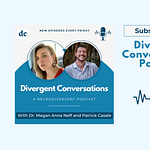Hello there 👋
In case you haven’t heard, it’s Autism Everything Month. (Yep — not just Awareness, not just Acceptance … everything. I’m considering trademarking it: AE™ — Autism Everything. Has a nice ring to it, no?)
… Kidding. That would be a very weird thing to try to trademark.
To mark the month, I’m launching a special Field Notes Friday series where I’ll be unpacking some of the research on who we’re still missing in autism conversations.
Here’s what we’ll be exploring:
Autistic girls and women
BIPOC individuals (most of the data we have centers children — and we’ll dip into ADHD here too)
The Lost Generation of Autistic Adults
Genderqueer and Trans individuals
Field Notes Friday is usually for paid subscribers only because, well, video makes me anxious. My obsessive tendencies spiral around getting things just right — and I feel safer knowing fewer people are watching if I flub a stat, have a dyslexic moment, or use a phrase that isn’t aligned with my values.
But this month, I’m pushing through those fears because this work matters. It matters more than the voice in my head whispering, 💭 “What if you got that one study wrong?”
So I’m making this series free to all subscribers, paid or not. If you’re subscribed, I hope you’ll join me. I think these conversations are worth having — messiness, nuance, and all.
Warmly,
Megan Anna
Conversation Entry Points
(P.S. Conversation entry points are still reserved for paid subscribers — for now. I’m noticing I’m struggling to keep up even with that pace. I get a lot of PDA and overwhelm from the sheer volume of notifications across platforms. But I genuinely enjoy connecting in quieter spaces — like here and in the Nook — and I want to set myself up for success instead of overwhelm and avoidance. I really wish I had more bandwidth for broader digital conversation, and I’m sorry if this ever feels limiting.)
When did you first start to wonder if you might be Autistic? Was there a specific moment, a slow build, or something in between?
How did gender expectations shape your early masking or self-perception? Were there moments you sensed you were "different" but didn't have language for it?
Were there things you excelled at that masked your internal struggles? (e.g., high achievement, people-pleasing, emotional caretaking)
(P.S. All are welcome to respond—this conversation isn’t limited to girls and women.)
P.S Autism Everything Month Sale Over at Neurodivergent Insights
(P.S. As part of Autism Everything month, we’re hosting a sale over at Neurodivergent Insights (use code AutismEverything for 40% off and 20% of proceeds from these purchases will go toward community support). The specific organizations will be chosen by Nookies during our advocacy conversations in the Learning Nook.
In the past, we’ve contributed to:
Shared aid networks
Palestine Children’s Relief Fund
Developing culturally-appropriate autism assessments for Latinx clinicians and communities
It’s always meaningful to see what unfolds when we move from individual reflection into collective action. So I’m excited to see what initiatives we get to collectively support this month.
Use Code: AutismEverything for 40% off
Interested In Learning More?
Explore our new course on The Lost Generation of Autistic Adults (50% off this month).
While it’s designed for clinicians, many late-identified adults have found it insightful for their own journey.
Citations
Barnard-Brak, L., Richman, D., & Almekdash, M. H. (2019). How many girls are we missing in ASD? An examination from a clinic-and community-based sample. Advances in Autism, 5(3), 214-224.
Dworzynski, K., Ronald, A., Bolton, P., & Happé, F. (2012). How Different Are Girls and Boys Above and Below the Diagnostic Threshold for Autism Spectrum Disorders? Journal of the American Academy of Child and Adolescent Psychiatry, 51(8), 788–797. https://doi.org/10.1016/j.jaac.2012.05.018
Rivet, T.T. and Matson, J.L. (2011), “Review of gender differences in core symptomatology in autism spectrum disorders”, Research in Autism Spectrum Disorders, Vol. 5 No. 3, pp. 957-76.
McCrossin, R. (2022). Finding the True Number of Females with Autistic Spectrum Disorder by Estimating the Biases in Initial Recognition and Clinical Diagnosis. Children, 9(2), 272. MDPI AG. Retrieved from http://dx.doi.org/10.3390/children9020272















Share this post